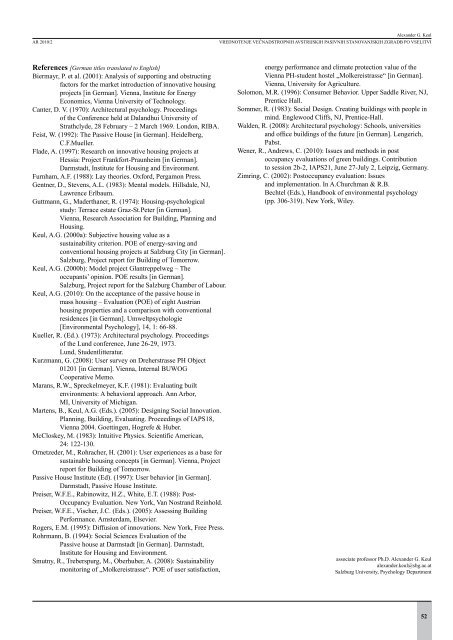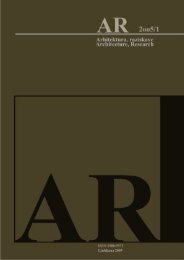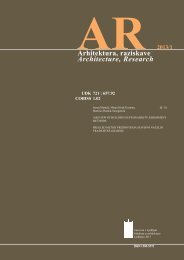<strong>AR</strong> <strong>2010</strong>/2Alexander G. KeulVrednotenje večnadstropnih avstrijskih pasivnih stanovanjskih zgradb po vselitviReferences [German titles translated to English]Biermayr, P. et al. (2001): Analysis of supporting and obstructingfactors for the market introduction of innovative housingprojects [in German]. Vienna, Institute for EnergyEconomics, Vienna University of Technology.Canter, D. V. (1970): Architectural psychology. Proceedingsof the Conference held at Dalandhui University ofStrathclyde, 28 February – 2 March 1969. London, RIBA.Feist, W. (1992): The Passive House [in German]. Heidelberg,C.F.Mueller.Flade, A. (1997): Research on innovative housing projects atHessia: Project Frankfort-Praunheim [in German].Darmstadt, Institute for Housing and Environment.Furnham, A.F. (1988): Lay theories. Oxford, Pergamon Press.Gentner, D., Stevens, A.L. (1983): Mental models. Hillsdale, NJ,Lawrence Erlbaum.Guttmann, G., Maderthaner, R. (1974): Housing-psychologicalstudy: Terrace estate Graz-St.Peter [in German].Vienna, Research Association for Building, Planning andHousing.Keul, A.G. (2000a): Subjective housing value as asustainability criterion. POE of energy-saving andconventional housing projects at Salzburg City [in German].Salzburg, Project report for Building of Tomorrow.Keul, A.G. (2000b): Model project Glantreppelweg – Theoccupants’ opinion. POE results [in German].Salzburg, Project report for the Salzburg Chamber of Labour.Keul, A.G. (<strong>2010</strong>): On the acceptance of the passive house inmass housing – Evaluation (POE) of eight Austrianhousing properties and a comparison with conventionalresidences [in German]. Umweltpsychologie[Environmental Psychology], 14, 1: 66-88.Kueller, R. (Ed.). (1973): Architectural psychology. Proceedingsof the Lund conference, June 26-29, 1973.Lund, Studentlitteratur.Kurzmann, G. (2008): User survey on Dreherstrasse PH Object01201 [in German]. Vienna, Internal BUWOGCooperative Memo.Marans, R.W., Spreckelmeyer, K.F. (1981): Evaluating builtenvironments: A behavioral approach. Ann Arbor,MI, University of Michigan.Martens, B., Keul, A.G. (Eds.). (2005): Designing Social Innovation.Planning, Building, Evaluating. Proceedings of IAPS18,Vienna 2004. Goettingen, Hogrefe & Huber.McCloskey, M. (1983): Intuitive Physics. Scientific American,24: 122-130.Ornetzeder, M., Rohracher, H. (2001): User experiences as a base forsustainable housing concepts [in German]. Vienna, Projectreport for Building of Tomorrow.Passive House Institute (Ed). (1997): User behavior [in German].Darmstadt, Passive House Institute.Preiser, W.F.E., Rabinowitz, H.Z., White, E.T. (1988): Post-Occupancy Evaluation. New York, Van Nostrand Reinhold.Preiser, W.F.E., Vischer, J.C. (Eds.). (2005): Assessing BuildingPerformance. Amsterdam, Elsevier.Rogers, E.M. (1995): Diffusion of innovations. New York, Free Press.Rohrmann, B. (1994): Social Sciences Evaluation of thePassive house at Darmstadt [in German]. Darmstadt,Institute for Housing and Environment.Smutny, R., Treberspurg, M., Oberhuber, A. (2008): Sustainabilitymonitoring of „Molkereistrasse“. POE of user satisfaction,energy performance and climate protection value of theVienna PH-student hostel „Molkereistrasse“ [in German].Vienna, University for Agriculture.Solomon, M.R. (1996): Consumer Behavior. Upper Saddle River, NJ,Prentice Hall.Sommer, R. (1983): Social Design. Creating buildings with people inmind. Englewood Cliffs, NJ, Prentice-Hall.Walden, R. (2008): Architectural psychology: Schools, universitiesand office buildings of the future [in German]. Lengerich,Pabst.Wener, R., Andrews, C. (<strong>2010</strong>): Issues and methods in postoccupancy evaluations of green buildings. Contributionto session 2b-2, IAPS21, June 27-July 2, Leipzig, Germany.Zimring, C. (2002): Postoccupancy evaluation: Issuesand implementation. In A.Churchman & R.B.Bechtel (Eds.), Handbook of environmental psychology(pp. 306-319). New York, Wiley.associate professor Ph.D. Alexander G. Keulalexander.keul@sbg.ac.atSalzburg University, Psychology Department52
Larisa BrojanEkološke in energijsko varčne hiše izslamnatih balECOLOGICAL AND ENERGY SAVING STRAW-BALE HOUSES<strong>2010</strong>/2 <strong>AR</strong>UDK 72 : 691.12COBISS 1.02prejeto 10. 10. <strong>2010</strong>izvlečekGradnja s slamnatimi balami v času, ko je velik poudarek naokolju prijazni gradnji, dobiva nove razsežnosti. Dolgo časaje bila aktualna le v krogu ljudi, ki so želeli graditi in bivatiskladno z naravo, vse pogosteje pa je možno <strong>za</strong>slediti konceptemoderne gradnje, kjer je predvidena uporaba slamnatih bal.Primerjava bilanc porabljene energije <strong>za</strong> proizvodnjo različnihgradiv razkriva, da je poraba energije pri izdelavi slamnatihbal izjemno nizka, kar pomeni, da ima gradnja s slamnatimibalami minimalen ogljikov in ekološki odtis. Slama namestosproščanja ogljika v atmosfero, predstavlja shranjevalnikogljika.Slama kot ostanek pridelovanja različnih vrst žit je na voljov ogromnih količinah, tudi v Sloveniji. Redki primeri gradnjes slamo v našem prostoru so lokalna atrakcija in vzbujajododatno <strong>za</strong>nimanje ter posledično odločanje posameznikov kizbiri tega materiala.Smiselnost uporabe slame kot gradbenega materiala dokazujejotudi predstavljeni primeri. Vključevanje in uporaba slame jepopolnoma primerno tudi <strong>za</strong> gradnjo v mestnem prostoru in nele <strong>za</strong> izven mestne projekte.ključne besedeslama, konstrukcija, mesto, ekološki in ogljikov odtisabstractStraw-bale construction acquires new dimensions in thistime, which is emphasising environment friendly construction.Over a long period of time it has been popular only within acircle of people who wished to build and live in harmony withnature, but ever more frequently we may come upon modernconcepts of construction which envisage the use of strawbales.Comparing the energy requirements for manufacturingvarious building materials reveals that energy consumption inthe manufacture of straw-bales is extremely low, which meansthat straw-bale construction results in a minimum carbon andecological footprint. Straw - rather than emitting carbon - actsas a carbon sink. Straw as a remnant of the harvest of differentcereals is available in huge quantities in Slovenia. The rarecases of straw-bale construction in our country are localattractions and arouse additional interest, and consequentlyinfluence the decisons of individuals to use this buildingmaterial.The examples presented prove that the use of straw as abuilding material is a reasonable choice. The inclusion anduse of straw in construction is also perfectly appropriate forbuilding in urban areas, and not only for out-of-town projects.key wordsstraw, construction, town, carbon emissionsGradnja s slamnatimi balamiZačetki gradnje s slamnatimi balami segajo v konec 19. stoletja,ko so v Nebraski (ZDA) zgradili prvi tovrsten objekt. Nekateriod teh objektov stojijo še danes in so stari preko sto let. Takratnirazlog <strong>za</strong> izbor slame kot gradbenega materiala je bila predvsemekonomska stiska graditelja. Uporabljen način gradnje se jeizka<strong>za</strong>l <strong>za</strong> <strong>za</strong>nesljivega, <strong>za</strong>radi česar se je <strong>za</strong>čel pojavljati vsepogosteje tudi v današnji praksi.Najbolj razširjena sta dva sistema gradnje s slamnatimi balami insicer samonosna slamnata konstrukcija ter skeletna konstrukcijas polnilom slame. Samonosna slamnata konstrukcija, imenovanatudi Nebraska style, je grajena po principu gradnje z opeko, toje polovično <strong>za</strong>mikanje med vrstami, medtem ko pri skeletnigradnji, največkrat gre <strong>za</strong> lesen skelet, se bale slame uporabikot polnilo. Pri obeh sistemih gradnja temelji na principu ročnevgradnje in na skupinskem delu. Na trgu gradbenih materialovje možno <strong>za</strong>slediti tudi t.i. slamnate prefabrikate. V tem primerugre <strong>za</strong> princip montažne gradnje z lesenimi okvirji, polnjenimiz balami slame.Kot vsaka tehnologija in gradivo, ima tudi uporaba slameprednosti in slabosti. Pri izvedbi moramo posebno pozornostnameniti reševanju detajlov ter s tem preprečiti previsokovsebnost vlage v slami, možnost požara, vdor živali inmikroorganizmov. Slama mora biti <strong>za</strong>ščitena s slojem, kivaruje slamo pred različnimi nepravilnostmi. Najbolj pogostaje obdelava z ilovnatim ometom na notranji strani ter apnenomalto na zunanji. Namesto apnene malte lahko uporabljamocementno, vendar v primerjavi z apneno, cementna malta manjdiha. Pogost način je tudi <strong>za</strong>piranje z lesom, v nekaterih primerihs steklom. Praviloma slama na pogled ni vidna in tako <strong>za</strong> mnogeobjekte niti ne vemo, da je osnovno gradivo slama.Ključnega pomena pri takšni gradnji je kakovost uporabljenihbal. Slama mora biti čista, to pomeni, da ne vsebuje semen,plevelov in drugih tujkov. Posamezno steblo mora biti dolgo,debelo in čim manj krat prelomljeno. Prav tako je pomembnasvežost slame, ki jo določajo barva, vonj in otip.Pri gradnji izbranega objekta je pomembno, da so uporabljenebale čim bolj enotnih lastnosti. Bale morajo biti kompaktne,kar preverimo z različnimi enostavnimi preizkusi [Lacinski etal. 2000: 79-81]; obliko mora obdržati in se ne sme razlesti, kostopimo nanjo ali jo spustimo z nižje višine, vanjo brcnemo alijo stresemo.Slika 1: Proces izdelave slamnatih bal se izvede nekaj dni po žetvi [vir:http://www.s-house.at/S-House_Broschuere.pdf].Figure 1: The straw-baling is done a few days after harvest.53

















